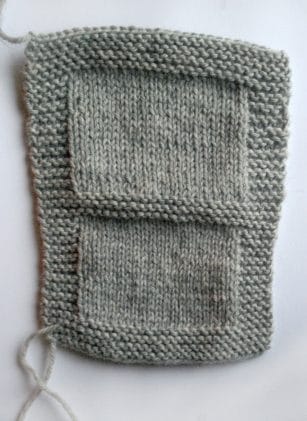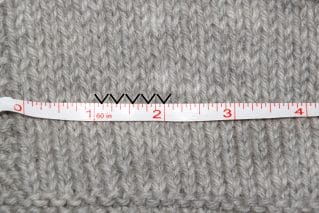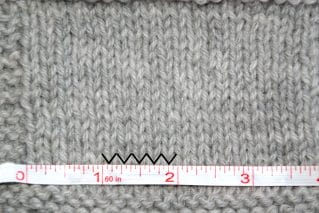Gauge is one of those things than can be a bit tricky to get
a hold of when you first start out knitting. Gauge is also one of those things
that will most likely remain finicky even when you have more experience with
it. It is no wonder so many people dislike gauge and swatches as some people
naturally knit loose and others knit tight. I am sure you have heard plenty
about how every person knits slightly different, but that got me thinking…how
much variance is in one’s own knitting? As an experiment in gauge, I decided make
a swatch where I knit using the continental method (how I normally knit) for
the lower half and the English method for the top half.
When knitters talk about gauge, all they are referring to is
how many stitches take up one inch. If you are a loose knitter, you will end up
with larger stitches which results in fewer stitches in each inch. And
conversely, a tight knitter will end up with smaller stitches, resulting in
more stitches in each inch. Depending on what the yarn or pattern that you are
using calls for, a loose knitter may go down in needle size to make up for the
bigger stitches and a tight knitter may up go in needle size to counteract the
smaller stitches.
As you can see in the picture below, the stitches in the top
half of the swatch are considerably looser than below. Additionally, notice how
the sides begin to flare out right around the middle where the top half begins.
This is due to the stitches being looser than in the lower half, where my
stitches are smaller and tighter.

When I measured my gauge in both sections, I was getting 5
sts/inch using the Continental style and 4.5 sts/inch with the English method.
Now, some might think “Come on! It is only half a stitch different!” Just how much
of a difference this half a stitch will make depends on how wide your project
is; the wider the knitting the more noticeable it will be. But in either case,
there will be a difference in width.
For example, say we are making a hat that has a
circumference of 18” and we need a gauge of 5 sts/inch. This means that we
would need to cast on 90 stitches (18 * 5). However, imagine that I am starting
this hat by knitting the in English method with the gauge in the picture below where I knit looser. In this case,
I am actually getting 4.5 sts/inch. This means that my hat would actually end
up larger than expected. If I take my 90 sts that I cast on and divide by my
gauge (90/4.5) I would actually get a hat that is 20” around. That half stitch
in this case made a difference of two whole inches!

4.5 sts/inch, my gauge while knitting in the English method
Take the same example, but switch the gauge around. In this
case, we are making the same 18” circumference hat but with a yarn that has a
gauge of 4.5 sts/inch. By multiplying our sts/inch with the circumference (18 *
4.5), we get a cast on number of 81 stitches. Imagine that now I were to use the
Continental style where my gauge is 5 sts/inch, as shown in the picture below. In this case, my hat would
actually be smaller than expected. Using the same formula as above where I take
my cast on number and divide by my sts/inch (81/5), we would end up with a hat
that is about 16” in circumference. Again, that half stitch per inch made a
difference of almost 2 inches.

5 sts/inch, my gauge while knitting in the Continental method
Next time you are knitting, why not try your own experiment
in gauge? By paying attention to your gauge while knitting, you might find
some surprising results! You might notice a slight difference while knitting in
the round vs. straight knitting, while using double pointed needles vs.
circular needles, or even while knitting with metal needles vs wooden needles. You
just might see that not only does gauge change from person to person, but it
can also change within your very own knitting depending on the knitting styles,
techniques or needles that you are using for each project.

